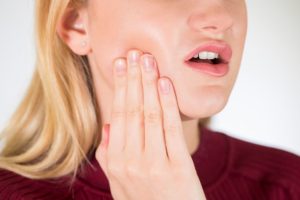 Jaw exercises and warm compresses are beneficial for temporomandibular joint disorder (TMJ). Common treatments for TMJ involve oral splints and braces, but many patients find more significant relief from jaw exercises and warm compresses along with these treatments being less painful and awkward.
Jaw exercises and warm compresses are beneficial for temporomandibular joint disorder (TMJ). Common treatments for TMJ involve oral splints and braces, but many patients find more significant relief from jaw exercises and warm compresses along with these treatments being less painful and awkward.
The recent study looked at self-care treatments for TMJ and facial pain.
Advertisement
TMJ refers to a group of common pain conditions that occur in the jaw joint and surrounding muscles. The muscular condition is known as myofascial temporomandibular disorder (mTMD) and affects 10 percent of women. People with TMD tend to have other pain conditions such as fibromyalgia, which is found in seven to 18 percent of patients.
Facial pain is often managed through the use of pain medications, splints, braces, and self-care techniques such as jaw exercises and warm compresses.
Study lead author Vivian Santiago explained, “Oral appliances are a common first-line treatment for TMD, despite mixed research results regarding their benefit. Even when oral splints have been found to have some benefit, they have not been found as effective for patients who also have widespread pain in the treatment of mTMD.”
The researchers examined how effective non-medication treatments are for TMD among women along with how effective patients perceive these treatments to be. Over 125 women were interviewed with 26 of them having both mTMD and fibromyalgia.
The most commonly reported treatments were oral appliances followed by physical therapy and at-home jaw exercises. Less common treatments included acupuncture, chiropractic services, trigger point injection, exercise, and meditation or breathing techniques.
The greatest improvement came from self-care practices such as jaw exercises, warm compresses, yoga and meditation, and massage. Eighty-four percent of patients reported that these techniques offered some relief while only 64 percent of patients reported benefits from oral appliances. About 11 percent of women did report that oral appliances worsened their symptoms.
Co-author Karen Raphael added, “Oral appliances did not outperform self-management care techniques in improving facial pain. Our results support the use of self-management as the first line of treatment for mTMD before considering more expensive interventions.”
Advertisement
Santiago continued, “While fibromyalgia is diagnosed by a physician, usually a rheumatologist, TMD is usually diagnosed and treated by a dentist. Our research suggests that dentists should ask patients with facial pain about whether they also have widespread pain, as this could provide more information to help plan their treatment.”
The researchers suggest that patients should be made aware of the wide array of available treatments – both medical and self-care treatment options – to obtain greater relief from their facial pain.
Also read:
- Essential oils for TMJ: Best oils, usage, and recipes
- TMJ home treatment: Exercises and home remedies to treat TMJ
